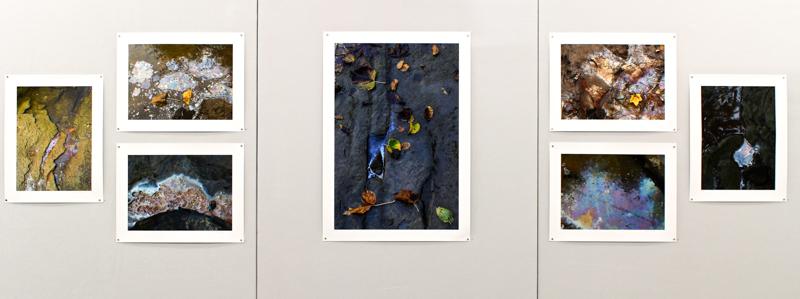Grashoff ’s New Book Uncovers Microscopic Life
Linda Grashoff’s photos from her new book, They Breathe Iron, depict iron-breathing microorganisms called Leptothrix discophora. Ginko Gallery & Studio will display her art through Nov. 15.
October 30, 2015
Photographer Linda Grashoff ’s new book They Breathe Iron brings together two dichotomies: nature versus technology and science versus art. 27 of the photos in They Breathe Iron are on view at Ginko Gallery & Studio through Nov. 15. Sometimes resembling oil spills, the photos demonstrate how advanced technology can measure and record subtleties of our environment, despite the numerous environmental disasters technology itself has created. However, Grashoff ’s photos actually depict beautiful organisms: tiny, ancient bacteria called Leptothrix discophora that live in an irradiant film of their own making and breathe iron the way humans breathe oxygen.
Grashoff’s photographs, which she gave a talk on last Tuesday at Mudd library, could easily stand on their own, but the emphasis she puts on scientific concepts sets the project apart from other environmental photographs. Her exploration of such concepts is unique in its accessibility and beauty.
Grashoff began work on They Breathe Iron in 2004. She explained how it was important to her to first understand the sci ence behind Leptothrix discophora before responding with photo- graphs and writings. Along with emeritus Professor of Biology Da vid H. Benzing, Grashoff consulted with Eleanor Robbins, a retired biologist from the U.S. Geological Survey, to learn the science behind the images that compelled her. “[Robbins] was so patient,” Grashoff said of the pair’s 10-year email correspondence. Grashoff sent photographs and questions to Robbins, who could respond with scientific information just by seeing the photographs.
Technology played an important role in other elements of the project as well. Initially, Grashoff had a difficult time finding a literary agent and publisher for her book. She sent it to 12 agencies unsuccessfully before turning to self-publishing in 2012 with the help of programs like Adobe Lightroom. “I could produce the book exactly to my liking,” she said.
Grashoff started shooting with film in 2004, but problems arose. “When the photos came back from the photo processor, they didn’t look quite like what [I] saw,” she said.
Eventually, as digital cameras developed further, things became easier. “It was heaven, because with the digital photograph … it often looked much more like what I saw than the [processed film photos did],” Grashoff said. “If it didn’t look exactly right, I could go into Photoshop and I could make it look exactly right.” Grashoff, with the aid of a microscope, uses technology to display what she observes with her trained eyes, zooming in on aspects of environments people often don’t know exist.
In her writing, Grashoff de-s cribes the microorganisms and writes about the bond she has formed with them. “Sometimes they’re not visible, sometimes they are visible but not photogenic,” she writes of Leptothrix discophora, as if the tiny creatures were camera shy. In They Breathe Iron’s first-person narrative, Grashoff describes bonding with nature through the photographs. “Taking photographs and naming features of the landscape are two ways I know to get closer to the physical world,” she writes. Perhaps Grashoff ’s investment in the process points to why she can spot the most beautiful, “photogenic” areas of Leptothrix discophora.
In a talk last Tuesday, Grashoff described the difficulties of the writing process. She said choosing a first-person narrative gave her more liberty in her writing and made the scientific aspects seem less dry because uninformed readers essentially learn with the narrator. However, this style was not without issue. Grashoff spoke of the questions she often asked herself throughout the process: “Was I giving too much information about myself or was I not divulging enough? Was I giving obvious information or was I [not] being explicit enough?”
Ultimately, Grashoff grounded her anxiety by emphasizing the connection between self and the environment, a theme she comes back to in much of her work. “Whatever I photograph comes down to one idea — I’m honoring the physical world,” Grashoff said. “I take photographs to be part of the physical process.” Digital cameras, emails, photo sharing and Adobe products have allowed her to honor — not translate — the world of which she feels she has become a part. It is a true luxury to be invited into that world through her photographs.
















